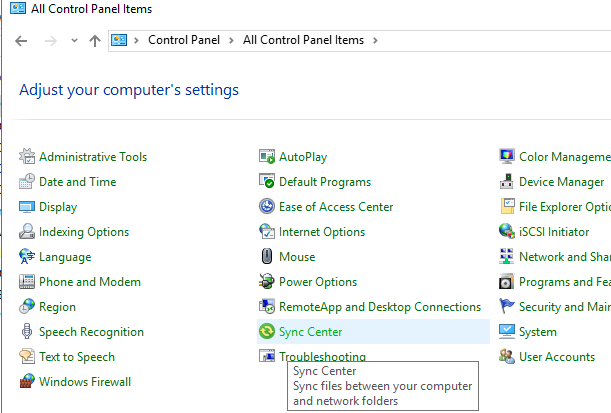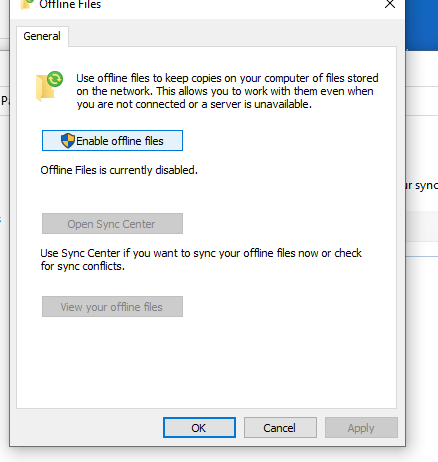Функция автономных (офлайн) файлов в Windows 10 позволяет сделать определенные сетевые папки или файлы доступными в автономном режиме, даже если ваш компьютер не подключен к корпоративной сети. В этой статье мы рассмотрим, как включить и настроить автономные файлы (Offline Files) в Windows 10/Windows Server 2016 вручную и с помощью групповых политик.
Автономные файлы доступны в экосистеме Windows довольно давно. Все что требуется от пользователя – включить Offline Files на компьютере и пометить определенные файлы или папки на сетевом ресурсе “всегда доступными в автономном режиме”. После этого Windows сохраняет указанные ресурсы в локальный кэш на диске и периодически обновляет его в фоновом режиме (раз в 2 часа — частоту синхронизации автономных файлов можно задать с помощью параметра GPO Configure Background Sync).
Содержание:
- Включить автономные файлы в Windows 10
- Включить Offline Files для сетевой папки на Windows Server
- Настройка автономный файлов с помощью групповых политик
Включить автономные файлы в Windows 10
В Windows 10 можно включить автономное файлы через классическую Панель управления.
- Откройте Центр синхронизации (Sync Center);
- В левой панели выберите “Управление автономными файлами” (Manage Offline Files);
- Нажмите на кнопку “Включить автономные файлы” (Enable Offline Files);
- Перезагрузите компьютер.
Теперь пользователю достаточно щелкнуть правой кнопкой мыши по файлу или папке в общей сетевой папке, который нужно сделать доступным автономном и выбрать пункт меню “Всегда доступно в автономном режиме” (Always available offline).
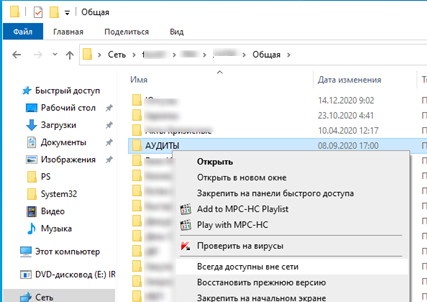
Windows начнет копировать указанные файлов в локальных кэш автономных файлов. По умолчанию размер кэша для автономных файлов в Windows составляет от 25% от емкости диска (в зависимости от версии Windows).
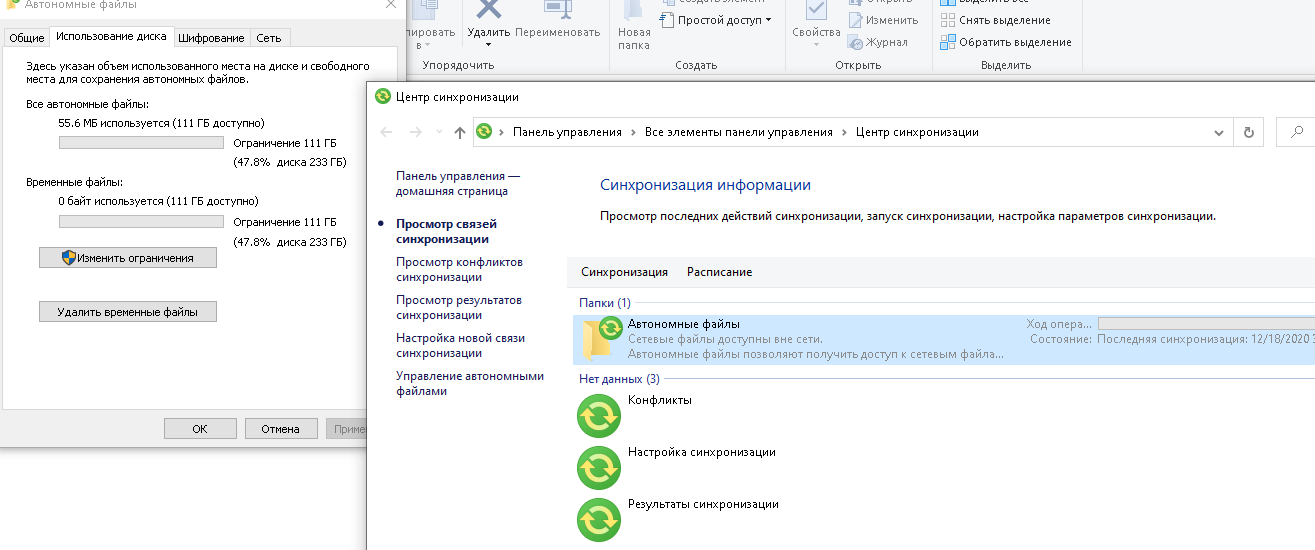
Теперь, если исходный файловый сервер недоступен, скорость сетевоегоподключения до него медленнее, чем заданное пороговое значение, эти файлы будут доступны для работы в автономном режиме через Центр синхронизации.
Все изменения, внесенные в автономные файлы, будут синхронизированы с сервером в следующий раз, когда компьютер подключится к сети.
Офлайн файлы сохраняются на клиентский компьютер в каталог
C:\Windows\CSC
и не доступны напрямую через File Explorer.
Включить Offline Files для сетевой папки на Windows Server
Чтобы пользователь мог помечать некоторые файлы доступными в автономном режиме, поддержка Offline Files должна быть включена в настройках сетевой папки.
В Windows Server 2016 запустите Server Manager и для роли File and Storage Services в свойствах общей сетевой папки включите опцию “Allow caching of share”.
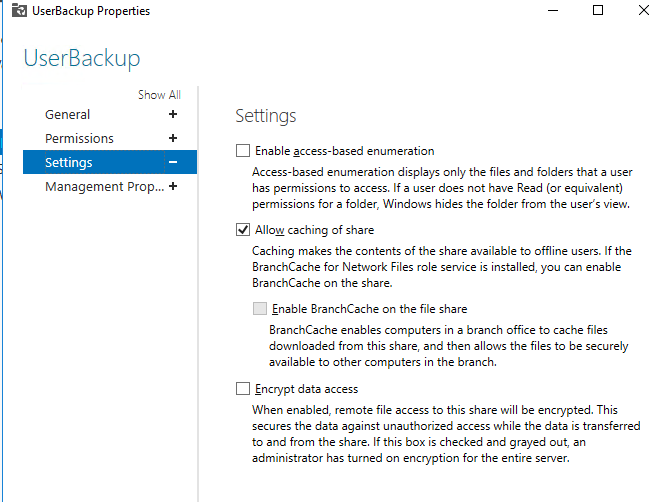
Можно включить ручной режим кэширования для сетевой папки с помощью PowerShell (в этом режиме пользователи могут вручную выбрать папки и файлы, которые нужно сделать доступными офлайн):
Set-SMBShare -Name Docs -CachingMode Manual
Если сетевая папка находится на компьютере с десктопной редакцией Windows, нужно в свойствах общей сетевой папки включить опцию Caching -> Only the files and programs that users specify are available offline.
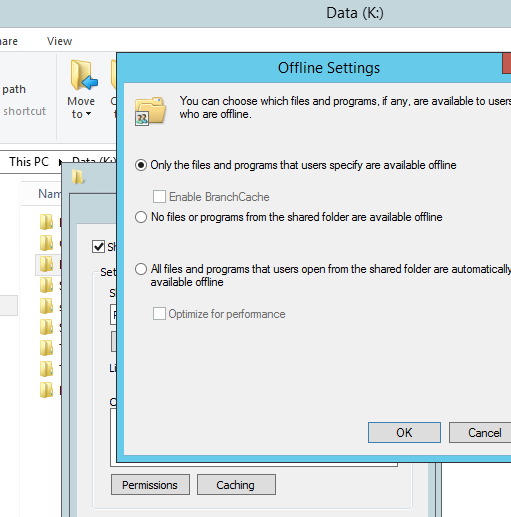
Настройка автономный файлов с помощью групповых политик
Если вы хотите включить службу автономных файлов на всех компьютерах в домене Active Directory, можно распространить на них следующие параметры реестра через GPO:
- HKEY_LOCAL_MACHINE\SYSTEM\CurrentControlSet\Services\CSC – тип DWORD Start = 1
- HKEY_LOCAL_MACHINE\SYSTEM\CurrentControlSet\Services\CscService
– тип DWORD Start = 2 - HKLM\Software\Policies\Microsoft\Windows\NetCache – тип DWORD Enabled=1
Либо можно использовать политику Allow or Disallow use of the Offline Files feature в разделе GPO Computer Configuration -> Policies -> Administrative Templates -> Network -> Offline Files. Здесь же можно настроить другие параметры Offline Folders:
- Configure Background Sync — включить фоновую синхронизацию и настроить интервалы синхронизации;
- Limit disk space used by Offline Files / Default Cache size – ограничить размер автономных файлов на диске;
- Specify administratively assigned Offline File – список сетевых ресурсов, которые автоматически должны быть синхронизированы на компьютеры пользователей и доступны в автономном режиме (можно указать UNC пути к любым сетевым папкам или личному каталогу пользователя \\Server1\Users$\%username%).
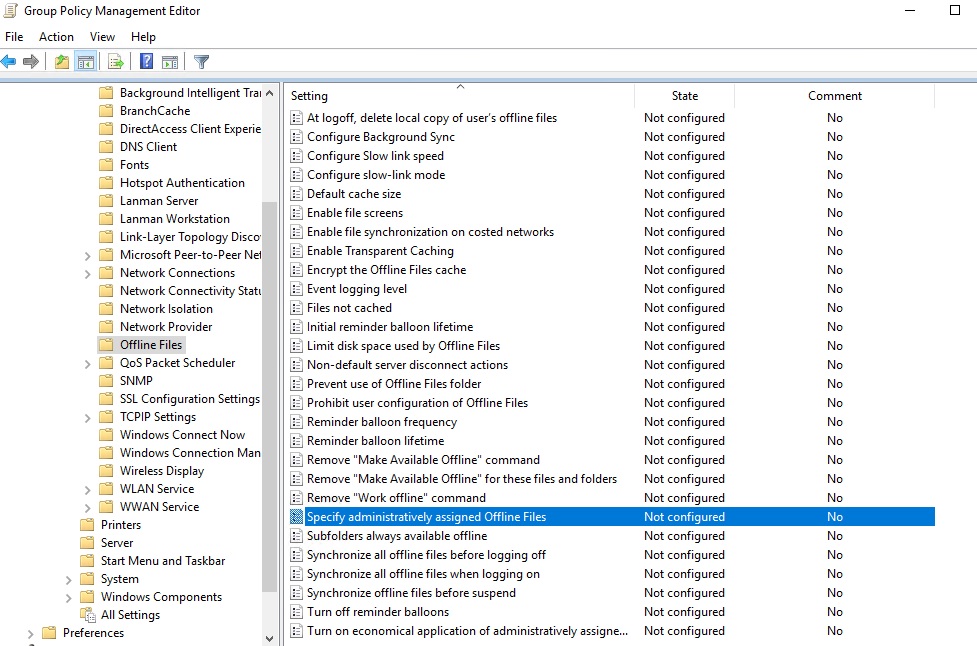
При анализе проблем работы с автономными файлами в Windows полезно исследовать события синхронизации в журнале Windows. Включите ведение лога синхронизации OfflineFiles:
wevtutil sl Microsoft-Windows-OfflineFiles/SyncLog /e:true /q
Затем, например, можно получить список успешно синхронизированных файлов за сутки с помощью такой PowerShell команды:
Get-WinEvent -oldest -filterhashtable @{ logname = "Microsoft-Windows-OfflineFiles/SyncLog"; starttime = (get-date).adddays(-1); id = 2005 } | select-object TimeCreated, @{ name = "Path"; expression = { ([xml]$_.toxml()).Event.UserData.SyncSuccessInfo.Path } }
Для очистки кэша автономных файлов нужно изменить параметра реестра Format Database и перезагрузить компьютер:
reg add HKEY_LOCAL_MACHINE\SYSTEM\CurrentControlSet\Services\Csc\Parameters /v FormatDatabase /t REG_DWORD /d 1 /f
shutdown –f –r –t 0
Способ 1: «Панель управления»
Использование соответствующего апплета классической «Панели управления» является наиболее удобным и очевидным способом управления службой «Автономные файлы» в Windows 10.
- Откройте классическую «Панель управления» командой
control, использованной в диалоговом окошке «Выполнить» (Win + R). - Найдите и запустите апплет «Центр синхронизации».
- Выберите в меню слева «Управление автономными файлами».
- Нажмите в открывшемся окошке кнопку «Отключить автономные файлы» и сохраните настройки.

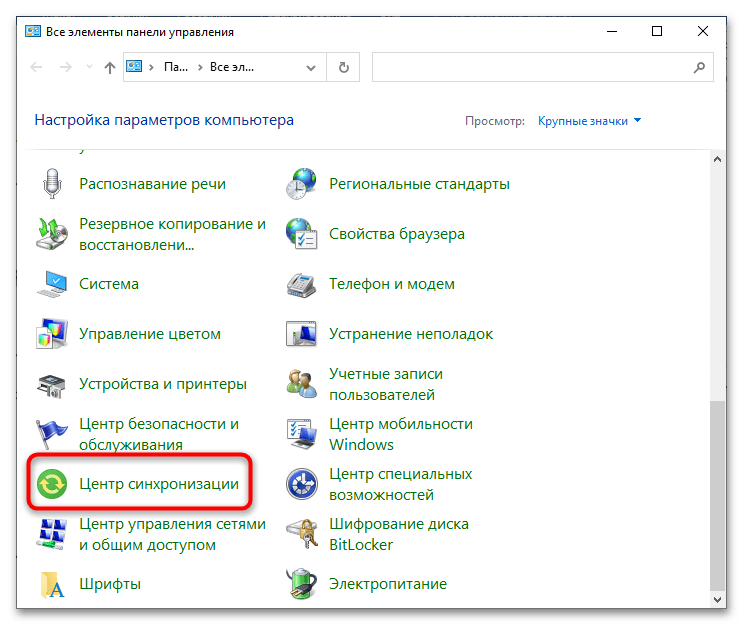
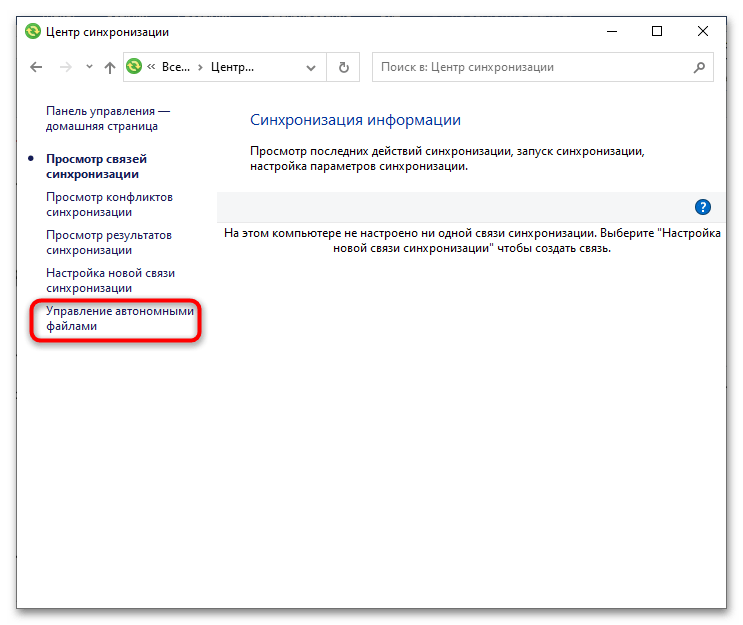
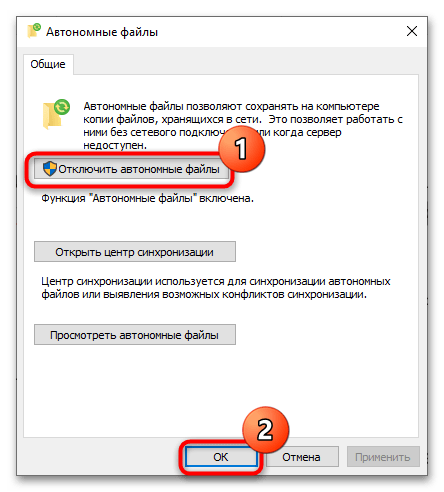
Способ 2: Локальные политики
На более низком уровне отключить функцию «Автономные файлы» можно в «Редакторе локальных групповых политик». Этот способ доступен в Windows 10 редакции Pro и выше. Обладателям редакции Home следует воспользоваться следующим способом статьи.
- Откройте «Редактор локальных групповых политик» при помощи команды
gpedit.mscи диалогового окна «Выполнить» (Win + R). - Перейдите в раздел «Конфигурация компьютера» → «Административные шаблоны» → «Сеть» → «Автономные файлы».
- Отыщите в правой колонке политику «Разрешить или запретить использование автономных файлов» и откройте ее настройки двойным по ней кликом.
- Активируйте радиокнопку «Отключено» и сохраните настройки.
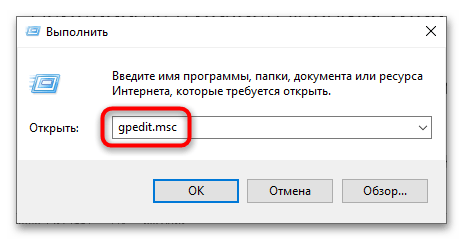
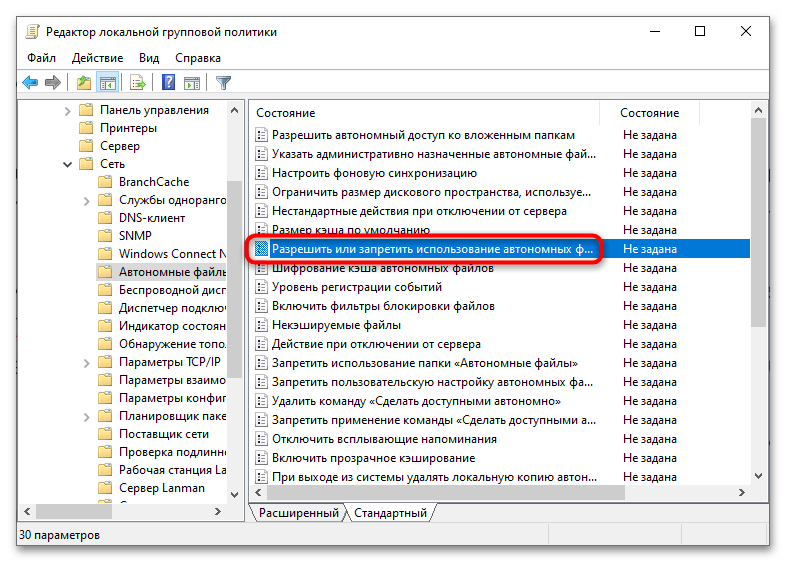
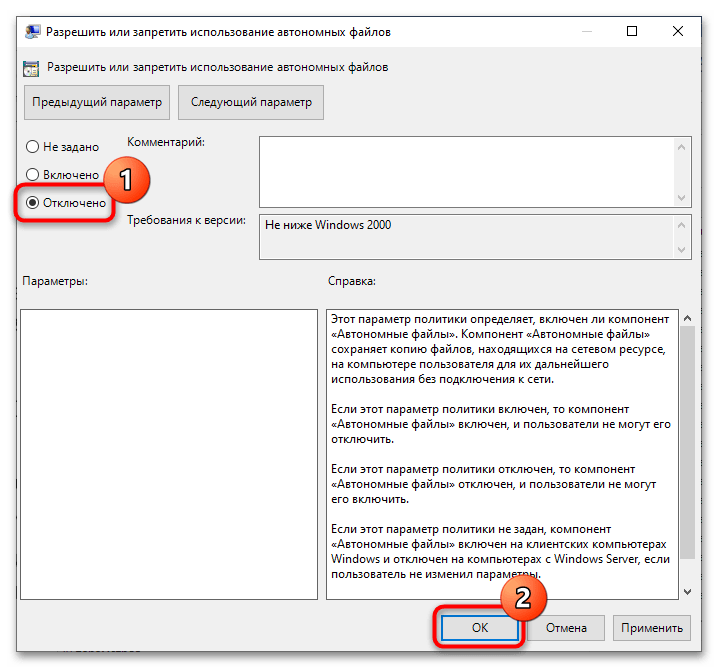
Чтобы настройки вступили в силу, необходимо будет перезагрузить компьютер либо обновить политики командой gpupdate /force, выполненной в классической «Командной строке» либо в консоли «PowerShell».

Способ 3: «Редактор реестра»
В Windows 10 Домашней редакции для отключения службы автономных файлов можно использовать «Редактор реестра».
- Запустите «Редактор реестра», выполнив в диалоговом окошке «Выполнить» (Win + R) команду
regedit. - Разверните ветку
HKLM\SOFTWARE\Microsoft\Windows\CurrentVersion\NetCache, кликните по последнему подразделу правой кнопкой мыши и выберите из меню «Создать» → «Параметр DWORD». - Дайте название созданному параметру «FormatDatabase», откройте окошко редактирования его значения двойным кликом и установите в качестве значения «1». Если параметр уже существует, ограничьтесь изменением его значения.
- Закройте «Редактор реестра» и перезагрузите компьютер.
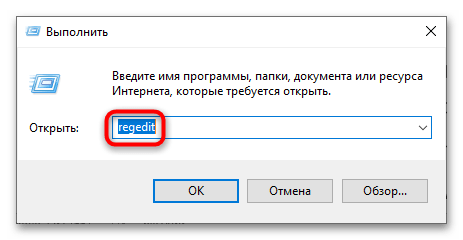
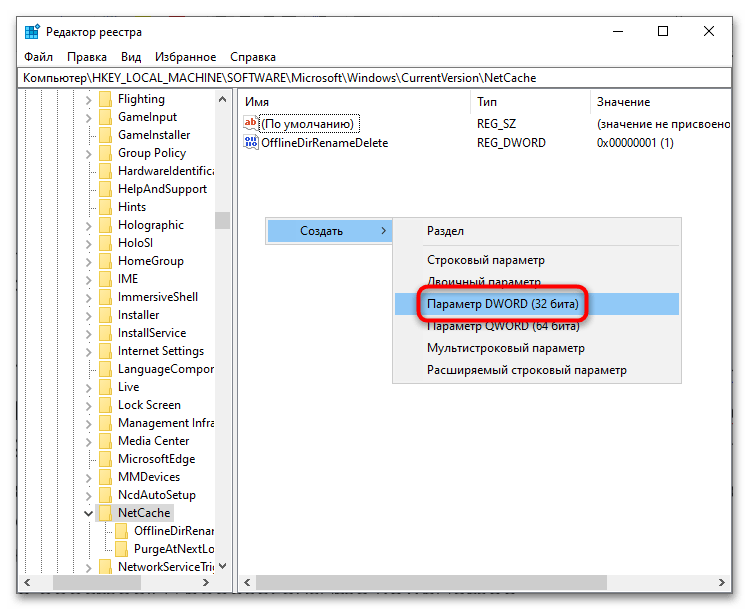

В результате функция «Автономные файлы» будет отключена. Этот способ дублирует предыдущий вариант, делая функцию управления автономными файлами недоступной.
Наша группа в TelegramПолезные советы и помощь
Offline files in Windows 10 provide great utility to the end-users. You can access, edit, and update them on the go — even without internet availability. But do you know how to enable and disable offline files? This article will describe three practical ways to enable and disable offline files in Windows 10. After reading this post, you can select any method on your own. But, before jumping into practical ways, here is a brief introduction of what exactly they are.
What Are Offline Files
Previously, files stored on a computer network were only accessible when there was an established connection with the network. However, the phenomena have changed now, thanks to the Sync Center in Windows 10 that keeps a copy of the files stored on a network. These copies are offline files, which you can access and edit without connecting to the network.
Having offline copies of the files stored on a network is a great utility, but there are some prerequisites of enabling and disabling them. Let’s have a detailed look at them.
Prerequisites of Enabling and Disabling Offline Files
There are some prerequisites for enabling and disabling offline files. First, having any edition of the Windows 10 operating system (OS) is better. Offline files work best with the Windows 10 OS, but millions of people still use Windows 7, 8, and 8.1.
If you have Windows 8 or 8.1, you can use the features of the offline file to work on the go. However, suppose you’re still on the Windows 7 OS. In that case, you need to confirm which edition you’re using, as offline files are only available on a few Windows 7 editions, such as Professional, Ultimate, and Enterprise.
To check which edition of Windows 7 you’re using, click the Start button, type Computer in the Search Box, and press Enter. Now, right-click on the Computer and open Properties. Here, you can see the edition installed on your PC.
3 Ways to Enable or Disable Offline Files in Windows 10
This article will specifically discuss how to enable and disable offline files only in Windows 10. If you’re a Windows 10 user, here are the three practical ways to perform this operation within a couple of steps.
Way 1. Enable/Disable Offline Files by Sync Center
Sync Center is your official gateway to enable and disable offline files in Windows 10. It’s a built-in tool that creates copies of the files stored on your connected network or server. Below is the step-by-step process to use Sync Center.
Step 1. Click the Windows 10 Search Bar, type Control Panel, and then open it. Here, you’ll find Sync Center if it’s already set up. Otherwise, you can also search for it in Control Panel. Click on the Sync Center icon.

Step 2. On the left side, you’ll see the Manage offline files option — click on it to proceed further.

Step 3. First, click on the Enable offline files option and then click the OK button at the bottom.
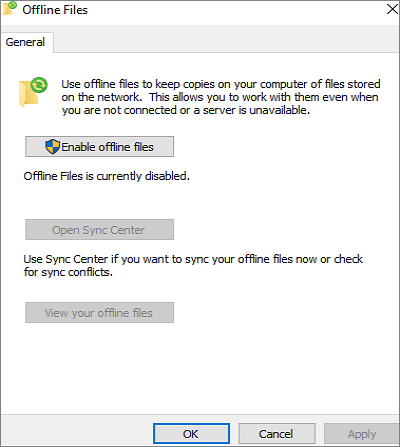
Step 4. A pop-up Window will ask you to restart your computer to apply the new settings. Click on the Yes button to successfully enable offline files.

Step 5. To disable offline files, open the Manage offline files again; now, click on the Disable offline files option and then click on the OK button.
Step 6. Restart your computer pop-window will appear again. Click on the Yes button to successfully disable offline files.
Related article to Sync Center not working on Windows 10:
Way 2. Enable and Disable Offline Files via Group Policy Editor
Another way to enable and disable offline files in Windows 10 is via the local group policy editor. It is a Windows administration tool to manage and configure different key settings. Here’s how you can use this editor to enable or disable offline files.
Step 1. Open the Local Group Policy Editor by typing «Edit group policy» in the Search Bar.

Step 2. Follow the below-given navigation pattern in the left pane of Local Group Policy Editor.
Computer Configuration > Administrative Templates > Network > Offline Files

Step 3. Find the Allow or Disallow use of the Offline Files feature in the right pane of Local Group Policy Editor and double-click on it.

Step 4. A new window will open with three different options, i.e., Not Configured, Enabled, and Disabled. Select Enabled or Disable according to your requirement and click OK to finish the process.

Way 3. Enable/Disable Offline Files Using Registry
Windows 10 lets you enable or disable offline files using the Windows Registry, which contains all the settings files of applications stored on the operating system. Just follow the below given step-by-step process to use this way.
Step 1. Press the Win + R keys to open the run command.
Step 2. Type regedit and press Enter to open the Registry Editor. Click Yes if the system asks you to allow this application to make changes.

Step 3. Follow the below-given navigation pattern in the left pane of the Registry Editor.
Computer\HKEY_LOCAL_MACHINE\SYSTEM\CurrentControlSet\Services\CSC

Step 4. Right-click in the right pane of the Registry Editor, and select DWORD (32-bit) Value.

Step 5. Rename its value as Start and change it from 20 to 1 in the value data box.

Step 6. Now, open the Cscservice folder, present below the CSC. Create another Start DWORD value, and set the value data to 2 this time. It will enable offline files on your computer.

Step 7. Change the value data to 4 for both the Start values you created in CSC and Cscservice to disable offline files in Windows 10.
Bonus Tip: Backup your Files with Cloud Backup Software
As time goes by, your computer may have many vital files. And storing them on your computer will take up storage space and is prone to computer viruses. At this time, you can use professional backup software to back up your files. EaseUS Todo Backup, a practical file backup software, comes to help.
EaseUS Todo Backup Home is a multi-functional backup tool for Windows 11/10/8/7. It can help you to back up systems, disks, partitions, etc. It lets you automatically back up files to an external hard disk and creates scheduled backups and full, incremental, and differential backups. You can easily migrate Windows 10 from HDD to SSD and clone a hard drive. Most importantly, it can offer you 250G of free cloud storage to meet your diverse storage needs.
The following are the steps to back up your files on your computer.
Step 1. To initiate a backup, click the Select backup contents option.
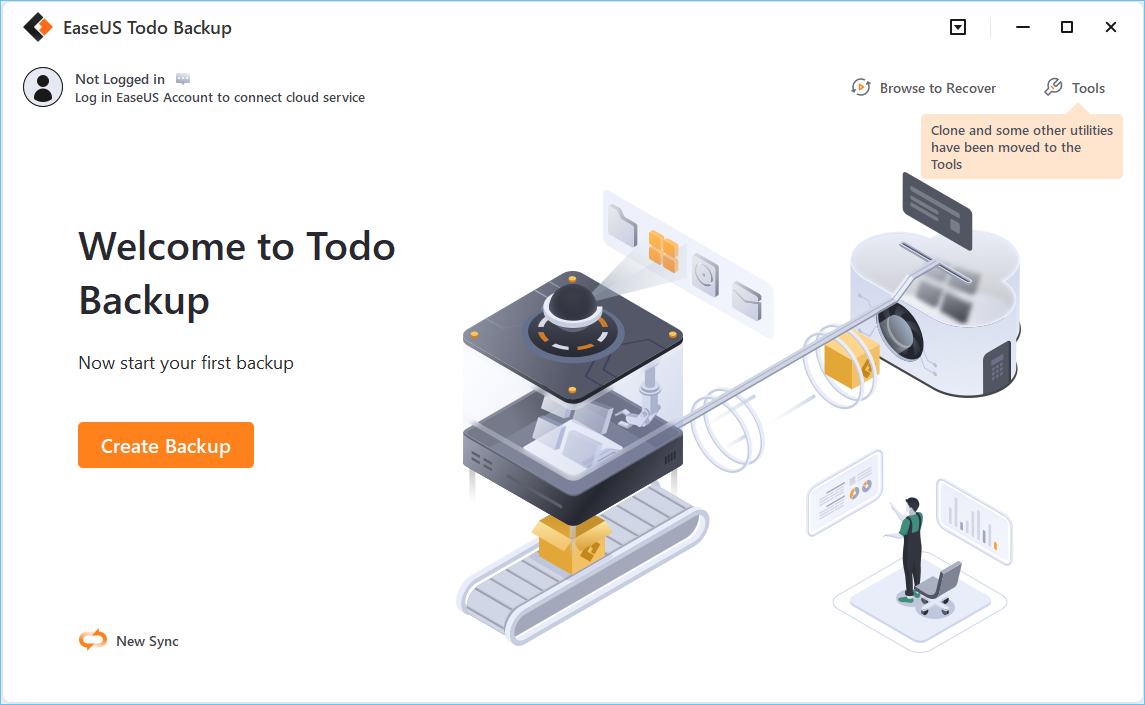
Step 2. There are four data backup categories, File, Disk, OS, and Mail, click File.

Step 3. On the left, both local and network files will be shown. You may extend the directory to pick the backup files.
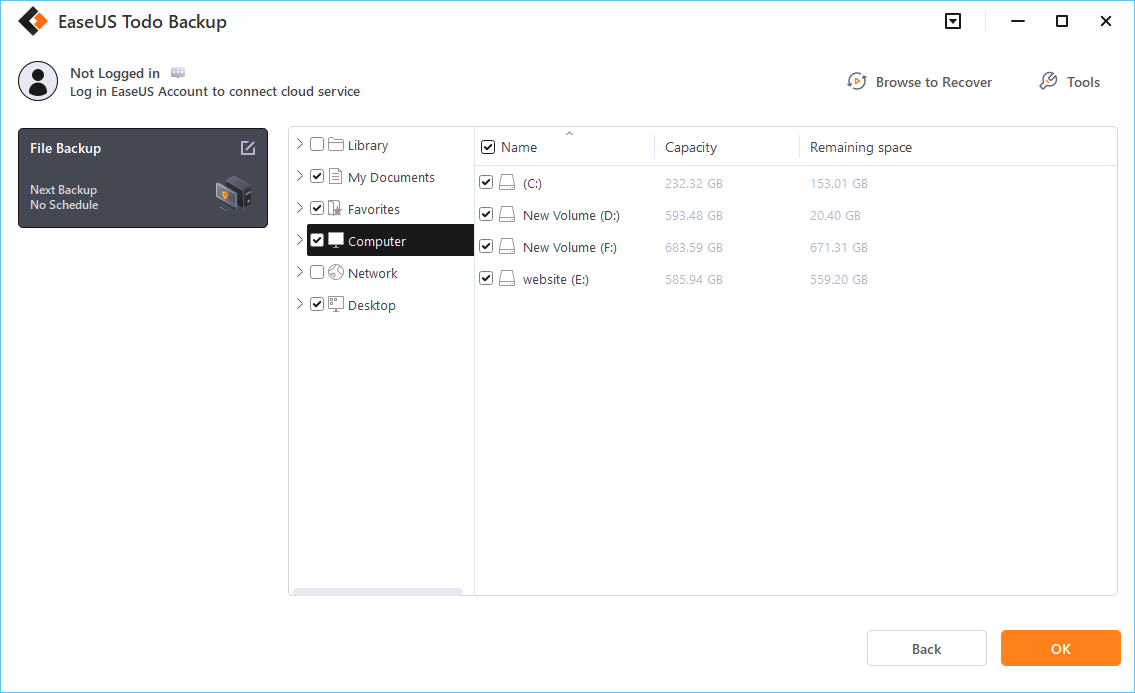
Step 4. Follow the on-screen instructions and choose a location to store the backup.
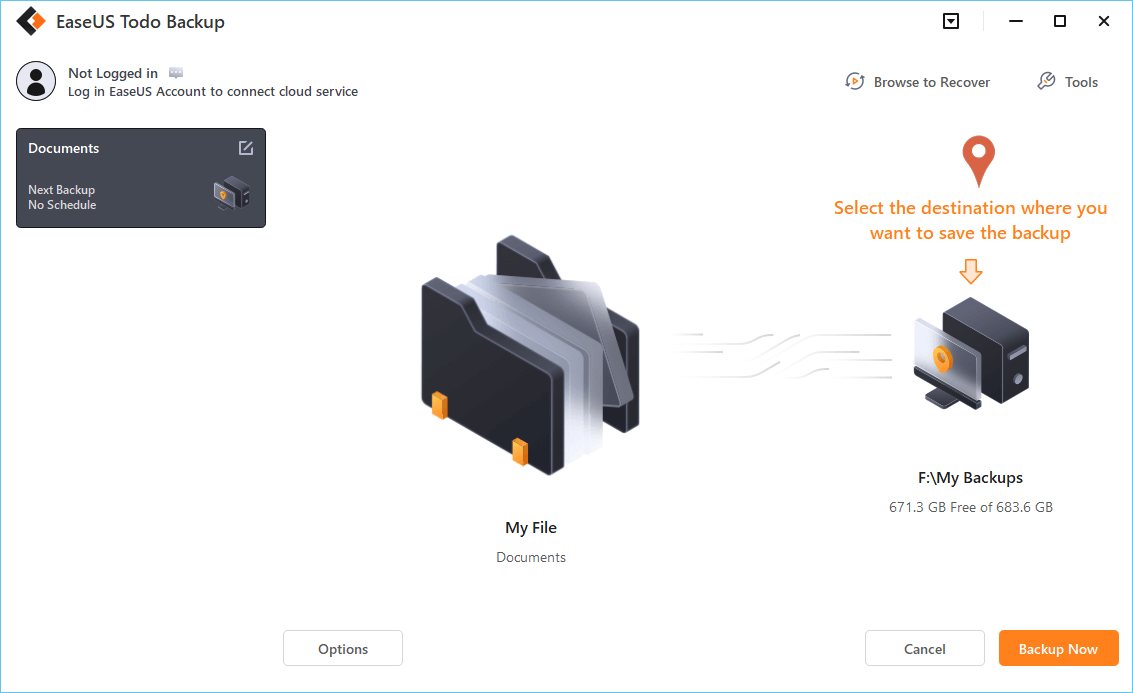
Click Options to encrypt the backup with a password in Backup Options, then click Backup Scheme to specify the backup schedule and start the backup at a certain event. There are also other additional choices you may choose to tailor the backup process to your requirements.
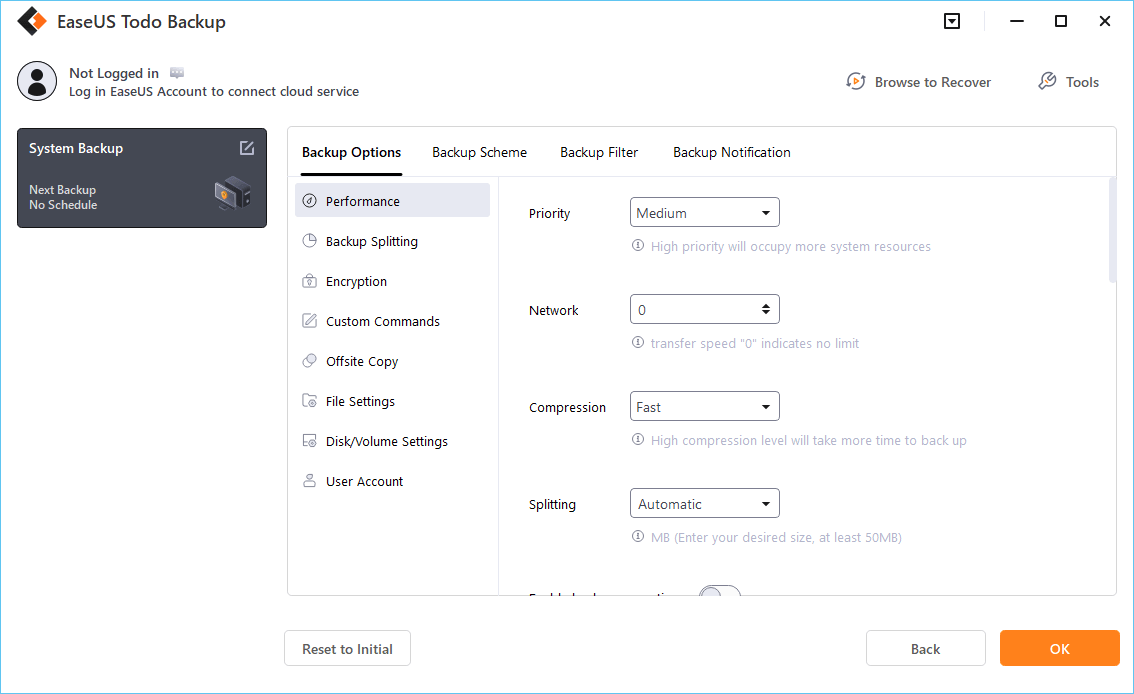
Step 5. The backup may be stored on a local disk, EaseUS’ online service, or NAS.
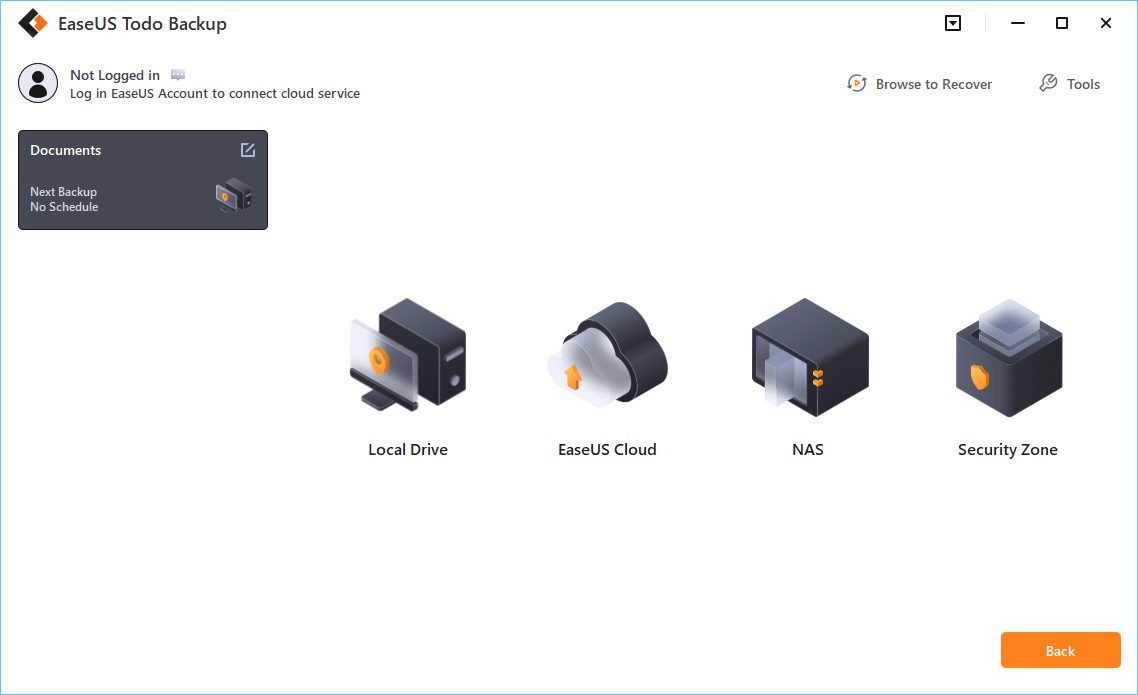
Step 6. EaseUS Todo Backup enables customers to back up data to a third-party cloud drive as well as its own cloud drive.
If you want to back up data to a cloud drive provided by a third party, choose Local Drive, scroll down to add Cloud Device, and then add and log in to your account.
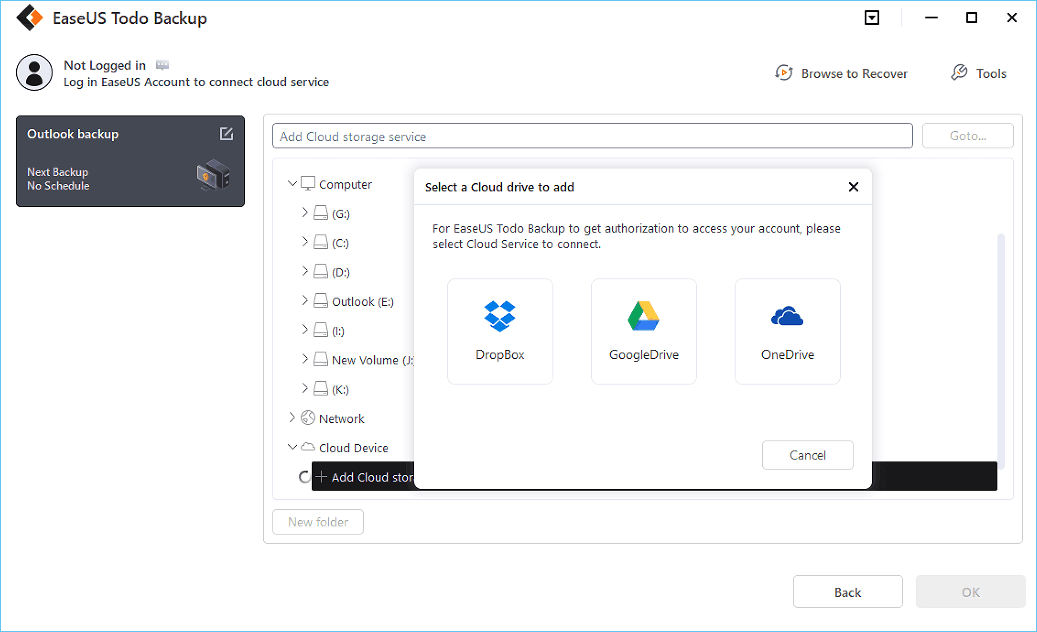
You can also choose the EaseUS cloud drive. Sign up for an EaseUS Account, then click EaseUS Cloud and log in.
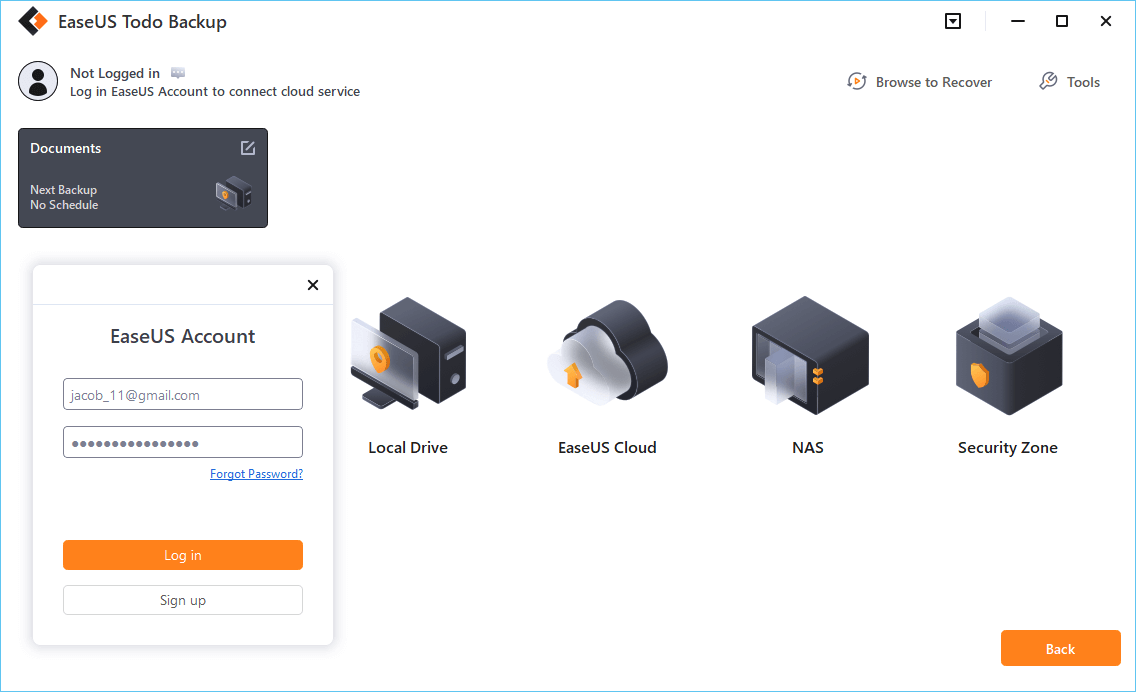
Step 7. Click Backup Now to begin the backup process. The backup job will be presented as a card on the left side of the panel after it has been finished. Right-click the backup job to handle it further.
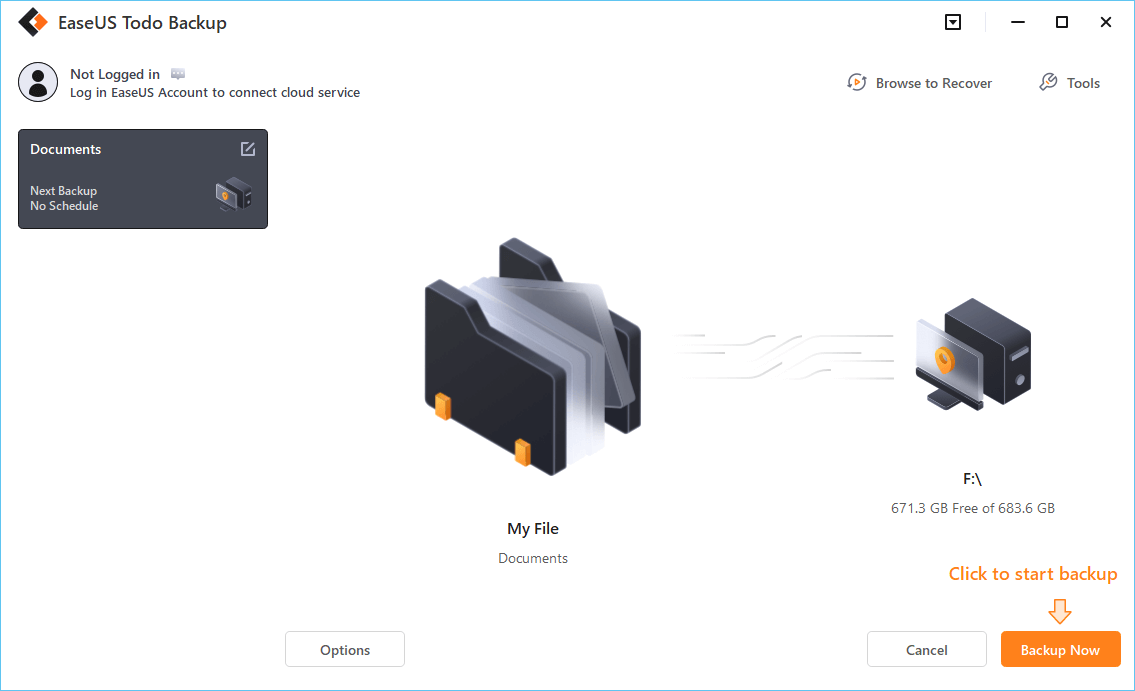
The Bottom Line
The newly adapted hybrid working environment has doubled the need for offline files. The availability to access, edit, and update files shared on a network while you’re working remotely has become eminent. Windows 10 offers the functionality to create offline files. Also, it’s pretty easy to enable and disable offline files within a couple of steps. This article has presented three practical ways to do the job with ease.
FAQs
1. What happens if I disable offline files?
If you disable the offline files, the Windows Sync Center will no longer create copies available on the connected server or network.
2. How do I get my folder back online?
Open File Explorer and click on the drop-down ribbon tab. Click on the Easy Access drop-down ribbon to open Map as drive. You can get back online from here.
3. How do I change offline files to online?
Open Sync Center from the Control Panel, and then choose to Manage offline files from the left side. Under the General tab, select Enable offline files and then click OK.
4. How do I know if Offline files are enabled?
Open Sync Center and see under the General tab. If you see Enable offline files, the files are currently disabled. Contrary to this, seeing Disable offline files indicates that files are now enabled.
Accessing files on a corporate network is easy. What happens when you’re offline but still want to keep working? Run offline files on your device so you can continue working without an internet connection. This post from MiniTool provides details about offline files Windows 10.
What Is Offline Files Windows 10
What is offline file? The Windows 10 offline files feature is a network feature of Sync Center that allows users to access files stored at another point on their network than their own computer, even if the network connection is not working.
All data made offline are saved in the offline files folder. If your system drive letter is the C drive, it is located in the C:\windows\CSC folder. You can view them at any time. If your computer is not connected to a network drive, the online-only network folder is empty with no files by default.
Offline files in Windows 10 are only available in Pro, Enterprise, and Education editions of Windows 10.
In addition to enabling offline files and always-on offline mode in Sync Center, your files may also be offline in the following situations.
- The connected server is unavailable.
- You have enabled work offline mode in File Explorer.
- The network connection speed is below a configurable threshold.
Why You Need Offline Files Windows 10
Why do you need offline files on your Windows? The first is that offline files can help you make exact copies of the web files you want to protect and use. The second is that you can access and view them at any time, especially when your computer is not connected to the network and server.
How to Enable/Disable Offline Files Windows 10
How to enable or disable offline files in Windows 10? There following are three ways available. Before enabling offline files Windows 10, please do the following preparations:
1. Create a shared folder to save all network files and folders to be synchronized.
- Create a folder. Right-click it to choose Properties. Then, click the Sharing tab and click Share.
- Click the arrow to choose Everyone to share with and click Add.
- Choose Read/Write under Permission Level and click Share.
- Go to the Sharing tab again. Click Advanced Sharing… and check the Share this folder In the same window, click the Permissions button and check the Allow box next to the Full Control option.
- After creation, go back to the Sharing tab and note down the network path.
2. Map the network drive to the local computer.
- Open This PC and select Map network drive under the Computer tab. Then, type the path of your shared folder and click Finish.
- Then, go to the mapped network drive. Right-click the files or folder you want to access to select the Always available offline option.
Way 1: Via Sync Center
How to enable offline files Windows 10? The first method is via Sync Center. Follow the guide below:
Step 1. Type Control Panel in the Search box to open it. Then, find Sync Center and click it to open.

Step 2. Click Manage offline files in the left panel.
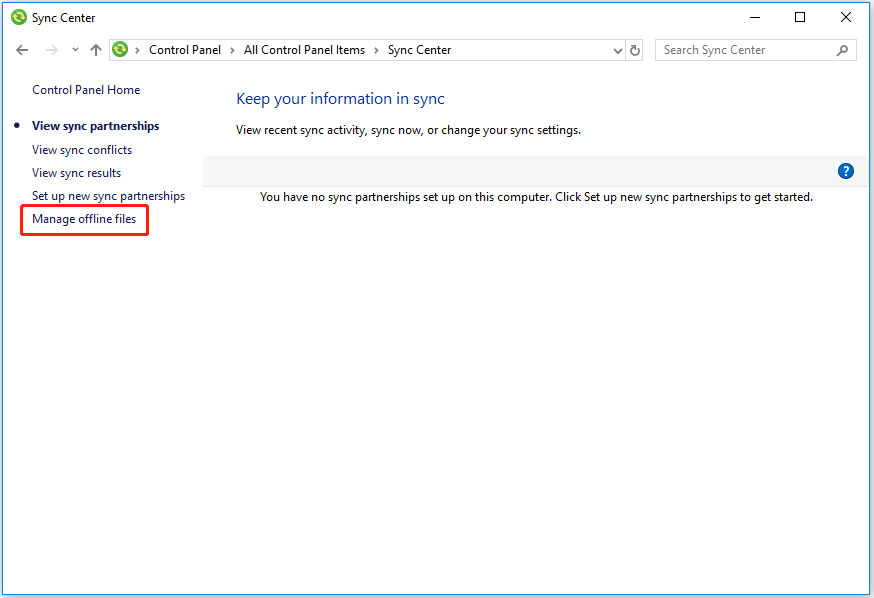
Step 3. Under the General tab, click Enable offline files and click Apply to enable it. After that, you will be asked to restart your computer. You just need to do that. Otherwise, you will encounter “Offline file is enabled but not yet active” in Windows 10 and your network files will not be synced to the local mapped drive.
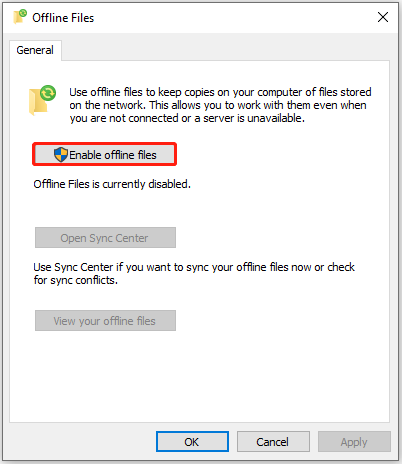
How to disable offline files Windows 10? You need to click Disable offline files in the Offline Files window. By default, the Enable offline files option will change to Disable offline files after you enable it.
Way 2: Via Registry Editor
The second method for you to enable offline files on Windows 10 is via Registry Editor. Here is how to do that:
Step 1. Type Registry Editor in the Search box to open it.
Step 2. Go to the CSC and CscService key in order with the following path.
HKEY_LOCAL_MACHINE\SYSTEM\CurrentControlSet\Services\CSC
HKEY_LOCAL_MACHINE\SYSTEM\CurrentControlSet\Services\CscService
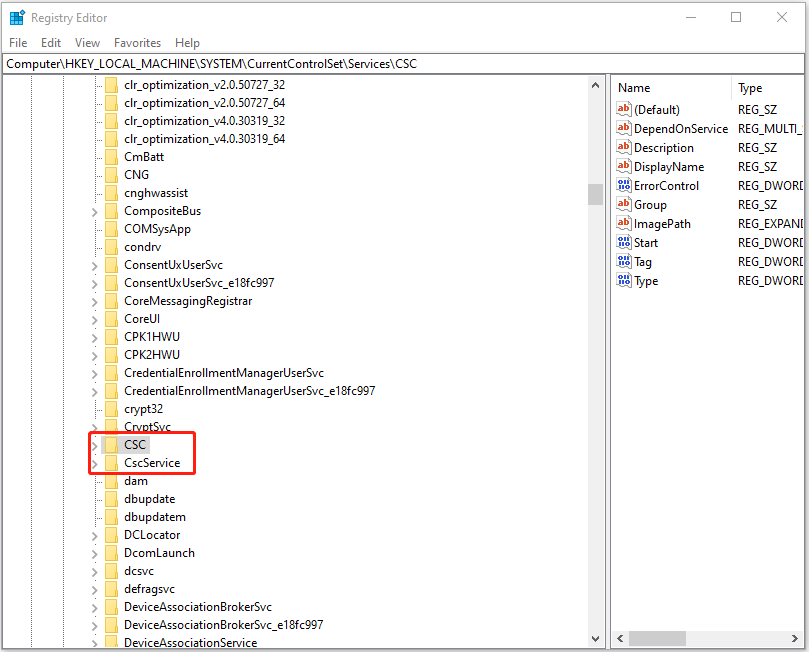
Step 3. Then, right-click the blank area in the right panel to select new and DWORD (32-bit) Value and set its name as Start.
Step 4. To enable offline files, set the start value of CSC and CscService to 1 and 2 in order.
Step 5. Restart your computer to save changes.
To disable offline files, you just need to set the start value of CSC and CscService to 4 and restart your computer to save changes.
Way 3: Via Local Group Policy Editor
How to enable offline files Windows 10? The third method for you is via Local Group Policy Editor.
Step 1. Type group policy in the Search box and then select Edit group policy from the start menu list.
Step 2. Go to Computer Configuration > Administrator templates > Network > Offline Files key.
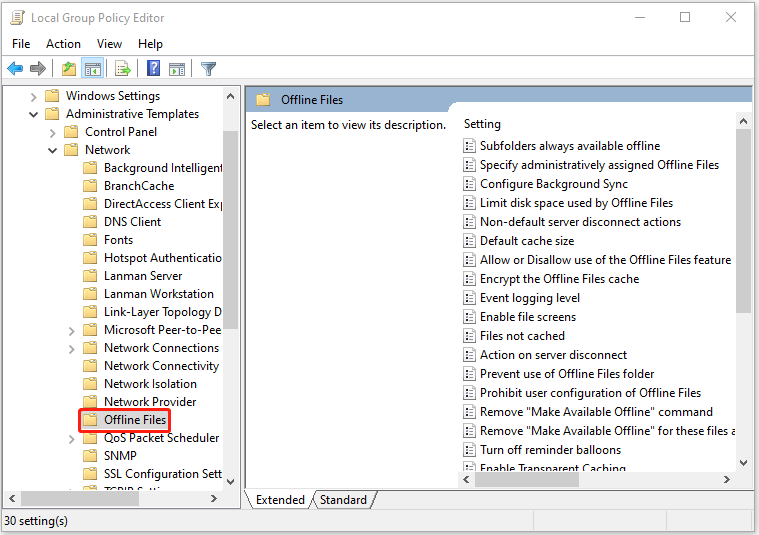
Step 3. Scroll down the Offline Files setting to find Allow or Disallow the use of Offline Files feature. Double-click it.
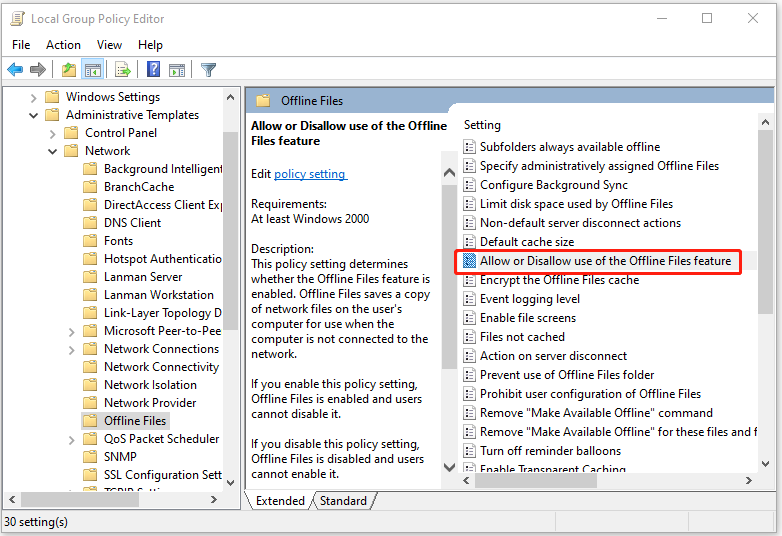
Step 4. Then you can enable or disable offline files based on your needs. To enable offline files, select Enabled in the next window. To disable offline files, select Disabled in the next window.
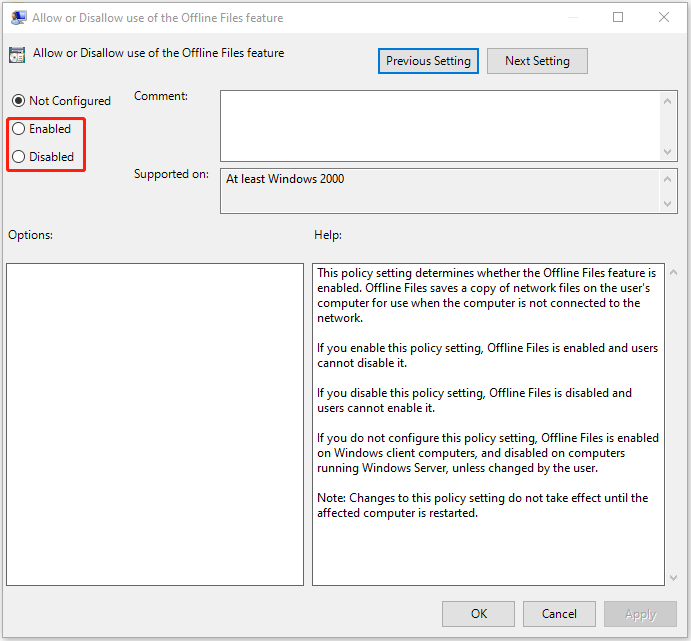
How to Configure Offline Files Windows 10
While the default settings are adequate for most users, Windows 10 offline files provide many settings that you can customize. For example, you can control the amount of local space used to store network files. You can enable encryption to add an extra layer of security. You can optimize offline files for slow network connections, and view and manage conflicts and results.
Next, we will introduce how to configure offline files Windows 10. Continue to read.
1. Check Offline Files disk usage
Follow the guide below:
- Type Control Panel in the Search box to open it. Then, find Sync Center and click it to open.
- Click Manage offline files in the left panel.
- Click the Disk Usage tab. Confirm the storage usage for the offline files.
- Click the Change limits button. Use the sliders to specify the maximum local space for offline and temporary files. Click the OK button.
- Click the Delete temporary files button and click the OK button.
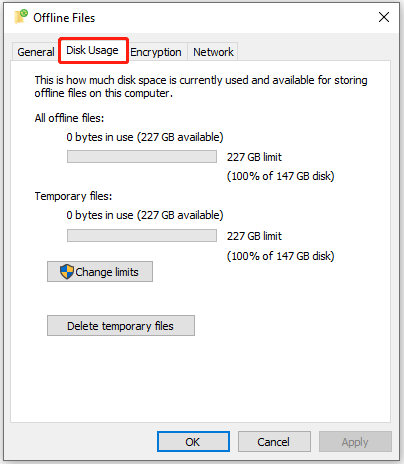
2. Encrypt or Unencrpt Offline Files
- Open Manage offline files again.
- Click the Encryption tab. Click the Encrypt button.
- Click the Unencrypt button to disable encryption and click the OK button.
- Once you complete the steps, the cached network files will remain encrypted.
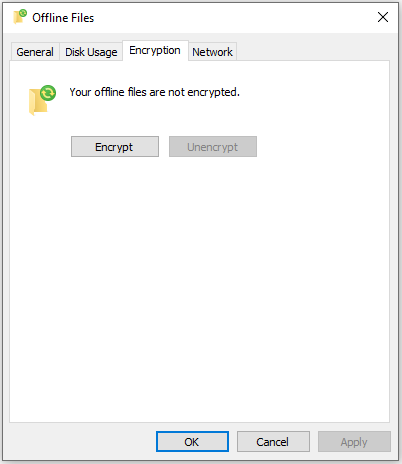
3. Optimize sync for slow connection
- Open Manage offline files again.
- Click the Network tab. Confirm the time (minutes) to check for a slow connection to sync files.
- Click the Apply button and click the OK button.
After you complete the steps, when you are working offline because of a slow network connection, Windows 10 will check the connection speed using the time you specified. If the network is sluggish, you will continue to work offline, but it will switch the connection to online if it’s good again.
4. View Synchronisation Conflicts
- Click the View synchronisation conflicts button from the left pane.
- Then, you can see the name, details, and modified data of the conflicts.
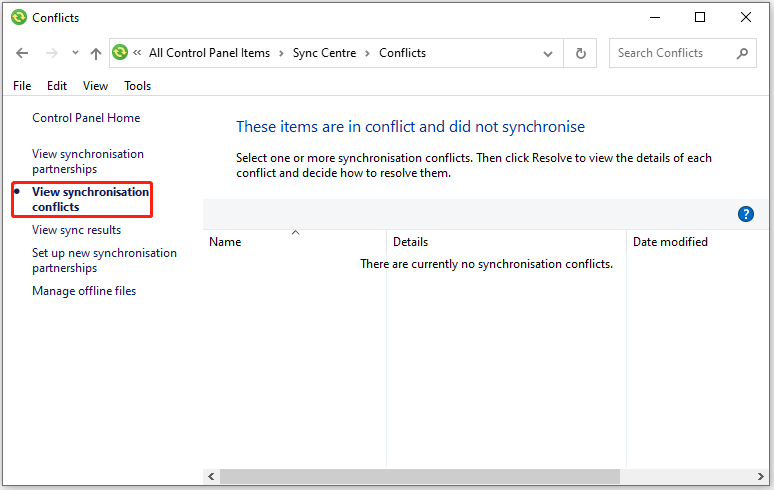
5. View sync results
- Click the View sync results button from the left pane.
- Then, you can see the name, details, and modified data of the results.

How to Sync Offline Files Windows 10
How to sync offline files on Windows 10? There are two ways for you.
Method 1: Sync Offline Files Manually
Step 1. Go to File Explorer > This PC > network locations, then select the mapped network drive created in advance.
Step 2. Right-click folders that contain offline files, then select Sync > Sync selected offline files.
Method 2: Sync Offline Files Automatically
Step 1. Open Sync Center again.
Step 2. Click the Offline Files folder, then you will see all the shared folders for offline files sync. Click Sync to sync the network files to the local computer immediately. You can click Schedule to make your files always in sync.
How to Sync Files to Network Drive
By now, you probably know how to sync network files locally using Offline Files in Windows 10. This is very useful for users who want to work with network files, allowing you to access and view them anytime you are offline from your computer.
But its steps are a bit complicated. Also, syncing is not always smooth and you may encounter various errors such as offline file conflicts, access denied, sync hangs, etc. There is an easier way to sync network files and keep them offline in Windows 10.
MiniTool ShadowMaker is a piece of professional Windows 10 backup software and it is designed to back up the files, folders, disks, partitions and the operating system. It also comes with the Sync feature, ensuring the files are in two or more locations and kept in pace. MiniTool ShadowMaker is one-way sync.
MiniTool ShadowMaker TrialClick to Download100%Clean & Safe
Detailed operating steps are listed as follows:
Step 1: Launch MiniTool ShadowMaker
- Please launch MiniTool ShadowMaker.
- Click Keep Trial.
Step 2: Specify Folders and Path to Sync
- Go to the Sync page and click it in the toolbar.
- Specify the source and destination for file sync.
What to Sync
- Go to the SOURCE section.
- Under the SOURCE tab, three paths are available: User, Computer, and Libraries. You can choose a source to select files. Then click OK to continue.
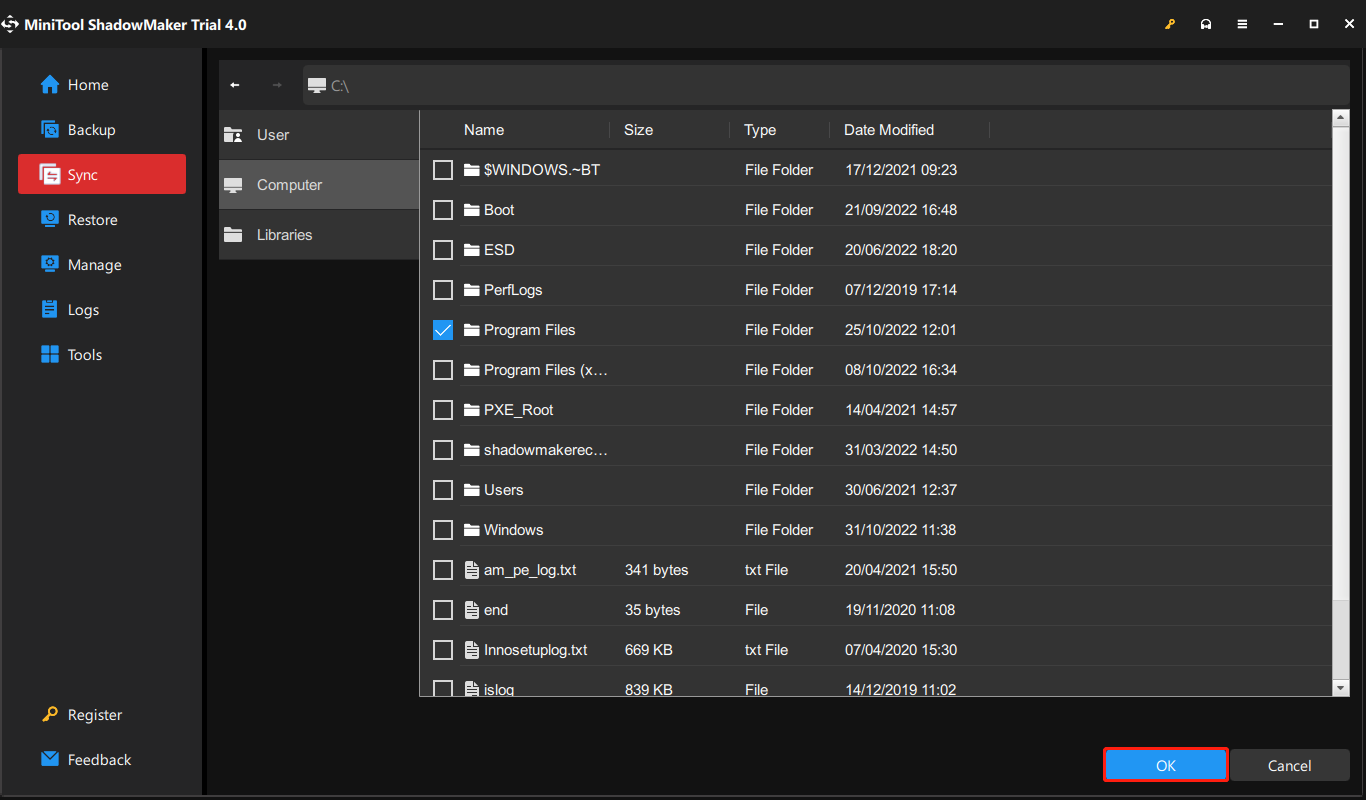
Where to save synchronized folders
Under the DESTINATION tab, there are four paths available: Administrator, Libraries, Computer, and Shared. To sync files among multiple computers, choose Shared, type Path, User name, and Password in sequence and click OK to finish.
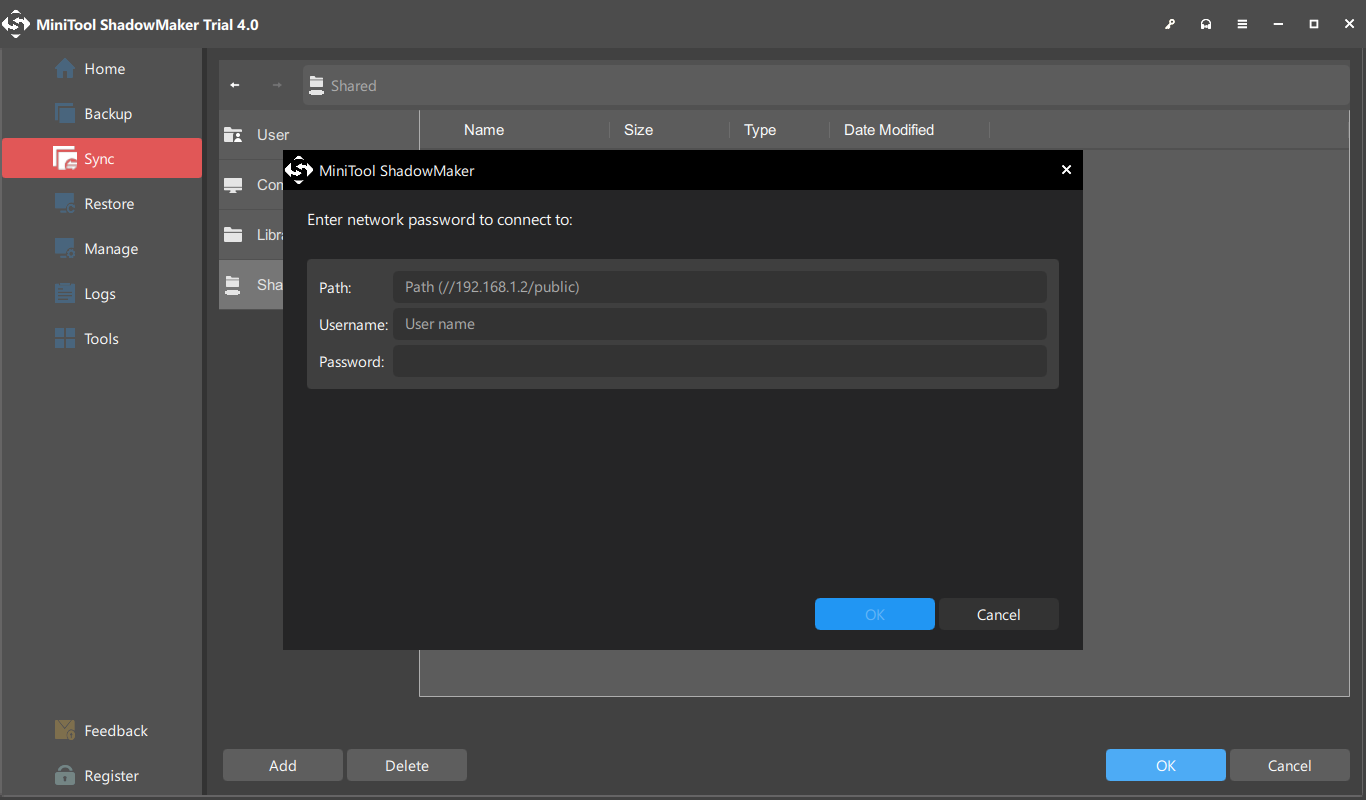
Step 3: Start to Sync Files to Another Computer
- Please go to Sync.
- You can click Sync Now to perform file sync or click Sync Later to postpone it. Besides, you can continue this sync task on the Manage page.
Bottom Lines
To sum up, this post shows what offline files Windows 10 is and how to enable and disable offline files Windows 10. If you have any problem with MiniTool ShadowMaker, please feel free to contact us via email at [email protected] and we will reply to you as soon as possible.
You are here: Home / Windows / How To Enable Or Disable Offline Files In Windows 10? – Ultimate Guide
The Sync Center in Windows 10 is an amazing feature that can synchronize locally stored files with files stored on network servers. This allows users to take their files anywhere without worrying about unstable network connections. These synchronized files that can be stored on your computer are called offline files.
In this article, I have discussed how you can enable or disable offline files in Windows 10.
We have shown a VIDEO walk through at the end of the post for easy solution.
What Is The Use Of Windows 10 Offline Files?
Offline files in Windows 10 are the locally stored files that are synced with your files in the Network servers. As the files can be accessed when the network is disconnected or the server is unstable, they are named as offline files. These files get updated whenever your computer connects to the network.
In Windows 10, offline files can be enabled using two methods. One is using the Control Panel and the other one is by using the Registry editor. Here is how you can enable offline files on Windows 10 using these 2 methods.
Enable Offline Files In Window 10 Using Control Panel
To enable offline files from the Control Panel, follow the steps given below:
- Type Control Panel in the search bar and select the appropriate option.
- After the Control Panel opens on your screen, click on the View By option and select Large Icons.
- Find the Sync Center option and click on it.
- Now, select the Manage offline files option, located on the left panel. The Offline Files dialog will open on your screen.
- Select the Enable offline files option. You may see Disable offline files option in its place. This will mean that Windows 10 offline files are already enabled on your PC.
If a confirmation prompt appears, then click on Yes.
- Finally, click on Apply and OK to save the changes and restart the PC.
Enable Offline Files In Window 10 Using Registry Editor
Another way to enable offline files on Windows 10 is by using the Registry Editor. All the Windows settings are stored in Registry, so you must be careful while using the Registry Editor. Follow the steps below exactly to avoid making any mistakes in the Registry.
- Press the Windows + R keys to open the Run utility.
- Type regedit and press Enter to open the Registry Editor.
- Navigate to the following Registry key:
Computer\HKEY_LOCAL_MACHINE\SYSTEM\CurrentControlSet\Services\CSC - Right-click on the white part in the right pane and select New> DWORD (32-bit) from the pop-up menu.
- Name the DWORD as Start and double-click on it.
- Change the value to 1 and click on OK.
- Now, navigate to the following Registry key:
Computer\HKEY_LOCAL_MACHINE\SYSTEM\CurrentControlSet\Services\CscService - Create another Start DWORD just like above and enter the value as 2. This will enable the offline files on Windows 10.
How To Disable Offline Files In Windows 10?
To disable the offline files on Windows 10, you can use the same methods as given above for enabling it with just some minute changes.
To disable Windows 10 offline files using Control Panel, simply open the Offline files dialog again and click on the disable offline files option. If you see the Enable offline file option in its place, it means that the offline files are already disabled.
To disable offline files from Registry Editor, simply change the value of the Start DWORD to 4 in the CscService key (steps 7 and 8).
Wrapping Up
So, there you have it. Now you know how to enable or disable offline files in Windows 10. If you have any questions regarding the Sync Center and offline files, ask them in the comment section below.

